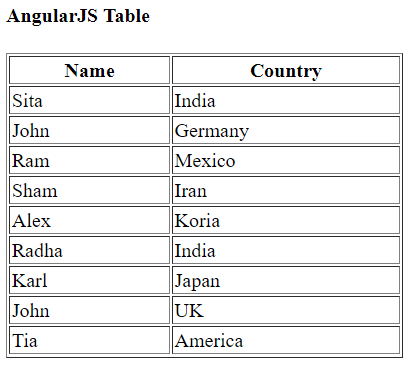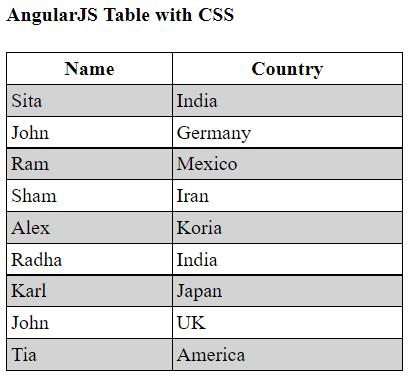AngularJS Tables - How we can create Tables in AngularJS
Learn how to display tables in AngularJS using the ng-repeat directive, making data presentation easy and quick in this step-by-step guide at rrtutors.com
AngularJS uses the ng-repeat directive to draw tables. With AngularJS, displaying tables is incredibly straightforward and quick. The table shows data in a format and distributed data with a particular heading.
Syntax
The following syntax helps to use any AngularJS filter with value in the expression.
|
<table> <tr> <th> Heading 1 </th> <th> Heading 2 </th> </tr> <tr ng-repeat = "scope_variable"> <td>{{ value1}}</td> <td>{{ value2 }}</td> </tr> </table> |
Examples
The following examples show the table and its data using the AngularJS function.
Example#1: The basic AngularJS table with its data.
|
<!DOCTYPE html> <html> <script src="https://ajax.googleapis.com/ajax/libs/angularjs/1.6.9/angular.min.js"></script> <body> <div ng-app="firstApp" ng-controller="firstCtroller"> <h4> AngularJS Table </h4> <table border="1" width="80%"> <tr> <th> Name </th> <th> Country </th> </tr> <tr ng-repeat="x in places"> <td>{{x.student}}</td> <td>{{x.country}}</td> </tr> </table> </div> <script> angular.module('firstApp', []).controller('firstCtroller', function($scope) { $scope.places = [ {student:'Sita',country:'India'}, {student:'John',country:'Germany'}, {student:'Ram',country:'Mexico'}, {student:'Sham',country:'Iran'}, {student:'Alex',country:'Koria'}, {student:'Radha',country:'India'}, {student:'Karl',country:'Japan'}, {student:'John',country:'UK'}, {student:'Tia',country:'America'} ]; }); </script> </body> </html> |
Output
 |
Example#2: The basic AngularJS table with CSS Style.
|
<!DOCTYPE html> <html> <head> <script src="https://ajax.googleapis.com/ajax/libs/angularjs/1.6.9/angular.min.js"></script> <style> table, th , td { border: 1px solid black; border-collapse: collapse; padding: 3px; } table tr:nth-child(even) { background-color: lightgrey; } </style> </head> <body> <div ng-app="firstApp" ng-controller="firstCtroller"> <h4> AngularJS Table with CSS </h4> <table border="1" width="80%"> <tr> <th> Name </th> <th> Country </th> </tr> <tr ng-repeat="x in places"> <td>{{x.student}}</td> <td>{{x.country}}</td> </tr> </table> </div> <script> angular.module('firstApp', []).controller('firstCtroller', function($scope) { $scope.places = [ {student:'Sita',country:'India'}, {student:'John',country:'Germany'}, {student:'Ram',country:'Mexico'}, {student:'Sham',country:'Iran'}, {student:'Alex',country:'Koria'}, {student:'Radha',country:'India'}, {student:'Karl',country:'Japan'}, {student:'John',country:'UK'}, {student:'Tia',country:'America'} ]; }); </script> </body> </html> |
Output
 |
Example#3: The AngularJS table with the "orderby" filter.
|
<!DOCTYPE html> <html> <head> <script src="https://ajax.googleapis.com/ajax/libs/angularjs/1.6.9/angular.min.js"></script> <style> table, th , td { border: 1px solid black; border-collapse: collapse; padding: 3px; }
table tr:nth-child(even) { background-color: lightgrey; }
</style> </head> <body> <div ng-app="firstApp" ng-controller="firstCtroller"> <h4> AngularJS Table with CSS </h4> <table border="1" width="80%"> <tr> <th> Name </th> <th> Country </th> </tr> <tr ng-repeat="x in places | orderBy:'student'"> <td>{{x.student}}</td> <td>{{x.country}}</td> </tr> </table> </div> <script> angular.module('firstApp', []).controller('firstCtroller', function($scope) { $scope.places = [ {student:'Sita',country:'India'}, {student:'John',country:'Germany'}, {student:'Ram',country:'Mexico'}, {student:'Sham',country:'Iran'}, {student:'Alex',country:'Koria'}, {student:'Radha',country:'India'}, {student:'Karl',country:'Japan'}, {student:'John',country:'UK'}, {student:'Tia',country:'America'} ]; }); </script> </body> </html> |
Output
 |
Summary
The AngularJS table helps to display large-size data in a proper format. It shows understandable data for all types of users. The AngularJS table uses CSS style and filters to offer information with a heading